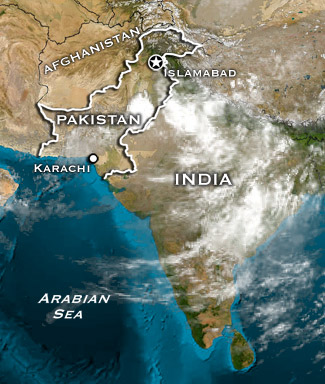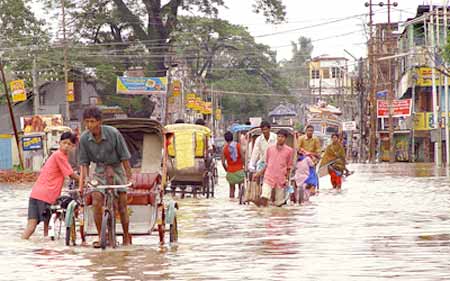![]()
Tormentas Tropicales, Monzones y Humedad del Suelo
¿Va a arreciar la tormenta?
¡No mires hacia el cielo, sino al el suelo!
Cuando las lluvias monzónicas (y quizás las que proceden de los huracanes) se adentran en las masas de tierra, pueden arreciar o amainarse. Hasta ahora, los expertos intentaban predecir lo que ocurriría mirando al cielo (analizando factores inherentes a la física de la atmósfera a ellas asociadas). Sin embargo, nuevos estudios señalan que lo que pudiera suceder depende fundamentalmente de la humedad del suelo, en el momento en que tales eventos meteorológicos entran en contacto con tierra firme. Tal hecho puede ayudar a predecir el riesgo de inundaciones con cierta antelación. Si ¡llueve sobre suelo mojado! Mucho Peor.

Sorprendente pero parece ser cierto. Estudios recientemente publicados en base a series temporales de más de 30 años (y modelos matemáticos), parecen constatar que, si el suelo se encuentra húmedo, la intensidad de estos fenómenos atmosféricos aumenta, siendo sus repercusiones más peligrosas. En otras palabras, pueden generar serias inundaciones. Si por el contrario, la superficie edafosférica está seca, el temporal amaina. Los investigadores sugieren que lo mismo podría suceder para el caso de los huracanes tropicales que azotan, a finales de verano y otoño, las costas americanas. Una pregunta (posiblemente estúpida, o tal vez no) que se me “escurre” es si cuando tales monzones o huracanes penetran por “extensas zonas agrícolas irrigadas”, sus consecuencias pueden ser más devastadoras que si lo hacen por áreas con agricultura de secano, en las que el suelo se encontraba seco (de darse ese caso). Según los autores de la publicación, de un suelo húmedo caliente, las tormentas secuestran más energía libre que de otro seco, como ocurre al entrar en contacto masas de aire frías con las calidas aguas marítimas que los refuerzan e incluso originan.

Inundaciones monzónicas en la India.
¿Curioso e interesante no? Poco más puedo decir, por cuanto la física de la atmósfera no es muy fuerte, precisamente. Los investigadores que haciendo uso de modelos de simulación, testaron sus resultados posteriormente con datos meteorológicos, abordarán seguidamente si tal hecho, constatado con los monzones asiáticos, acaece de igual forma para los huracanes americanos.
Juan José Ibáñez
Tropical Storms Endure Over Wet Land, Fizzle Over Dry
ScienceDaily (Aug. 27, 2009) — If it has already rained, it’s going to continue to pour, according to a Purdue University study of how ocean-origin storms behave when they come ashore.
More than 30 years of monsoon data from
«Once a storm comes overland, it was unclear whether it would stall, accelerate or fizzle out,» said Dev Niyogi, Indiana state climatologist and associate professor of agronomy and earth and atmospheric sciences. «We found that whether a storm becomes more intense or causes heavy rains could depend on the land conditions – something we’d not considered. Thus far we’ve looked at these storms based mainly on ocean conditions or upper atmosphere.»
Niyogi said tropical storms gain their strength from warm ocean water evaporation. «The same phenomenon – the evaporation from the ocean that sustains the storms – could be the same phenomenon that sustains that storm over land with moisture in the soil,» he said. «The storm will have more moisture and energy available over wet soil than dry.»
Niyogi’s team’s findings were published in the August edition of the journal Geophysical Research Letters. Storm data fed into a model showed that higher levels of ground moisture would sustain Indian monsoon depressions. The model’s prediction was proven when compared to ground conditions for 125 Indian monsoons over 33 years, where storms sustained when the ground was wet at landfall. Knowing the sustainability of a storm could lead to better predictions on flooding and damage inland before a monsoon or a hurricane makes landfall. «We think the physics is such that we could see similar results more broadly, such as in the United States,» Niyogi said.
The National Science Foundation and NASA funded the research. The Purdue led-team also consisted of researchers from the
Journal reference:
Chang et al. Possible relation between land surface feedback and the post-landfall structure of monsoon depressions. Geophysical Research Letters, 2009; 36 (15): L15826 DOI: 10.1029/2009GL037781
Adapted from materials provided by Purdue University.
Tropical Storms Endure Over Wet Land Fizzle Over Dry
by Staff Writers.
If it has already rained, it’s going to continue to pour, according to a
More than 30 years of monsoon data from India showed that ground moisture where the storms make landfall is a major indicator of what the storm will do from there. If the ground is wet, the storm is likely to sustain, while dry conditions should calm the storm. «Once a storm comes overland, it was unclear whether it would stall, accelerate or fizzle out,» said
Niyogi said tropical storms gain their strength from warm ocean water evaporation. «The same phenomenon – the evaporation from the ocean that sustains the storms – could be the same phenomenon that sustains that storm over land with moisture in the soil,» he said. «The storm will have more moisture and energy available over wet soil than dry.»
Niyogi’s team’s findings were published in the August edition of the journal Geophysical Research Letters. Storm data fed into a model showed that higher levels of ground moisture would sustain Indian monsoon depressions. The model’s prediction was proven when compared to ground conditions for 125 Indian monsoons over 33 years, where storms sustained when the ground was wet at landfall.
Knowing the sustainability of a storm could lead to better predictions on flooding and damage inland before a monsoon or a hurricane makes landfall. «We think the physics is such that we could see similar results more broadly, such as in the United States,» Niyogi said.
The National Science Foundation and NASA funded the research. The Purdue led-team also consisted of researchers from the National Center for Atmospheric Research, NASA-GSFC/ESSIC, the University of Georgia, the Indian Space Research Organization and the Indian Institute of Technology Delhi. Niyogi said the next step is to use the model and ground moisture data to test these theories for hurricanes in the

[…] Tormentas Tropicales, Monzones y Humedad del Suelo […]